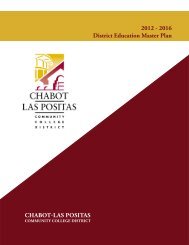City College of San Francisco - California Competes
City College of San Francisco - California Competes
City College of San Francisco - California Competes
Create successful ePaper yourself
Turn your PDF publications into a flip-book with our unique Google optimized e-Paper software.
STANDARD III.D<br />
II. Standard Report III.D: Financial Resources<br />
Financial resources are sufficient to support<br />
student learning programs and services and to<br />
improve institutional effectiveness. The distribution<br />
<strong>of</strong> resources supports the development,<br />
maintenance, and enhancement <strong>of</strong> programs<br />
and services. The institution plans and manages<br />
its financial affairs with integrity and<br />
in a manner that ensures financial stability.<br />
The level <strong>of</strong> financial resources provides a<br />
reasonable expectation <strong>of</strong> both short-term<br />
and long-term financial solvency. Financial<br />
resources planning is integrated with<br />
institutional planning.<br />
III.D.1.a. Financial planning is integrated with<br />
and supports all institutional planning.<br />
The <strong>College</strong>’s unrestricted general fund has an<br />
annual operating budget <strong>of</strong> approximately $170<br />
million. [Ref. 1] The true cost <strong>of</strong> serving the<br />
current number <strong>of</strong> students in a near-optimal<br />
manner would require a much larger budget.<br />
This situation is even more challenging due to<br />
the inadequate level <strong>of</strong> financial support the<br />
state provides for noncredit education. [Ref. 2]<br />
To make informed and intelligent decisions<br />
related to the distribution <strong>of</strong> relatively scarce<br />
resources, the <strong>College</strong> has implemented a<br />
comprehensive budget planning system that<br />
integrates financial planning with institutional<br />
planning. [Ref. 3] There is a strong connection<br />
between the priorities contained in the Strategic<br />
Plan 2003-2008 and the Annual Plan that the<br />
Planning and Budgeting Council recommends<br />
to the Board <strong>of</strong> Trustees each year. All significant<br />
expenditures for each major cost center are tied<br />
directly to one <strong>of</strong> the <strong>College</strong>’s planning objectives<br />
during the development <strong>of</strong> the annual<br />
budget. Specifically, the Annual Plan serves as<br />
an operational version <strong>of</strong> the <strong>College</strong>’s plans<br />
for a one-year period; it consists <strong>of</strong> a set <strong>of</strong> institutional<br />
objectives that are to be achieved by<br />
the <strong>College</strong> through the efforts <strong>of</strong> the <strong>College</strong>’s<br />
organizational units—departments, schools, and<br />
administrative operations. [Ref. 4] Thus, the unit<br />
plans are linked to the Annual Plan, just as the<br />
Annual Plan is linked to the <strong>College</strong>’s overall<br />
Strategic Plan. [Ref. 5] While this does not guarantee<br />
that all objectives are funded, it does help<br />
to ensure that resources are spent in ways that<br />
support planning objectives.<br />
The Planning and Budgeting Council (PBC),<br />
a Shared Governance committee, reviews this<br />
information at a set <strong>of</strong> open meetings conducted<br />
each spring. Requests to the PBC for funding<br />
must demonstrate a direct connection to the<br />
<strong>College</strong>’s Strategic Plan. This system ensures that<br />
all <strong>of</strong> the institution’s major constituency groups<br />
have a say in how available resources are used to<br />
achieve the goals and objectives in the <strong>College</strong>’s<br />
Strategic Plan. The role <strong>of</strong> the PBC has gained<br />
a great deal <strong>of</strong> acceptance across the <strong>College</strong> as a<br />
key part <strong>of</strong> a fair process for creating the annual<br />
budget and for ensuring that longer-term efforts<br />
that require additional funding are phased into<br />
the budget over a series <strong>of</strong> years. While these<br />
documented connections between planning<br />
and budget are shared with the Board <strong>of</strong> Trustees<br />
prior to their adoption <strong>of</strong> the final budget, an<br />
earlier more concise presentation <strong>of</strong> the information<br />
would be valuable. [Ref. 3] This approach<br />
has enabled the <strong>College</strong> to continue to make<br />
steady progress in its efforts to address the needs<br />
<strong>of</strong> its students. At different times, funding for<br />
increasing the Class Schedule, backfilling student<br />
services budgets in the face <strong>of</strong> state funding cuts,<br />
and improving basic skills education have all<br />
been accomplished using this approach.<br />
III.D.1.b. Institutional planning reflects realistic<br />
assessment <strong>of</strong> financial resource availability,<br />
development <strong>of</strong> financial resources, partnerships,<br />
and expenditure requirements.<br />
CITY COLLEGE OF SAN FRANCISCO<br />
209







